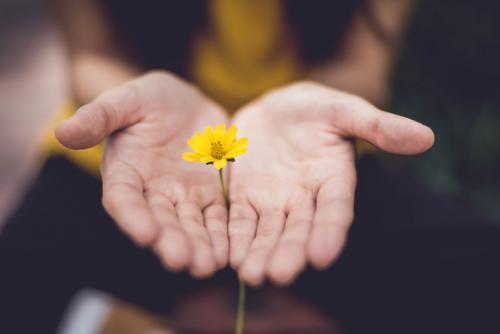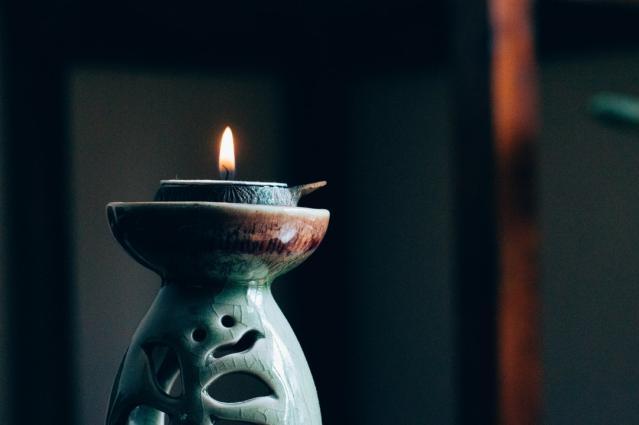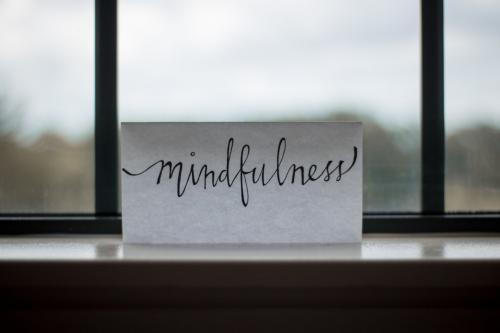One of the best ways to improve wellness naturally is to employ certain mindfulness techniques. These techniques are often very simple and straightforward but we often take them for granted because we think they are just too trivial in comparison to our more complex and busy lives.
What is mindfulness?
According to Mindful.com, mindfulness “is the basic human ability to be fully present, aware of where we are and what we’re doing, and not overly reactive or overwhelmed by what’s going on around us.”
In this busy world we live in, we often lose sight of the bare necessities of life and succumb to its pressures. Because of this, stress, anxiety, and depression come creeping in and steal our joy. This then robs us of our health and wellness.
If you are one of the millions of people whose health has been affected by the pressures of life, applying the following mindfulness techniques may be your first step to improving your wellness naturally.
1. Live in the Moment

“Enjoy your present without connecting the events with your past and future. You don’t have to worry about anything because things unfold in a natural manner. Peel off all the insecurities and just concentrate on your work. Embrace the freshness of this moment to analyze the beauty of NOW. Mindfulness means to be aware of what is happening in the present moment.
“In order to live this moment, you have to love your job, your surroundings, your life. Do everything with pure joy. Stop listening to all those people who try to dilute your presence. Start doing all the things you always wanted to do. Start making a wish list of all the things which are close to your heart.” via 10 Easy Ways To Practice Mindfulness
2. Start Your Day with a Short Morning Meditation

“Meditation is a great tool to help to balance your mind and create peace with who and what you are. Often we are not able to control our emotions and thoughts can emerge at any given time. Often the thoughts that emerge are negative and they don’t help us with what we want to achieve.
Meditation allows you to order your mind and thoughts and help to eliminate negativity in your life. A clearer mind will help you to be calmer, better aligned and helps you to give a place to negative feelings in order to focus on positivity.” via Why You Should Start Your Day With Morning Meditation
3. Free Yourself from All Distracting Thoughts

“Without direction and a map, you can get off course and end up in places you never wanted to go. A typical day can be choked with 50 things to do, many of which have nothing to do with your Focus. When your mind and efforts are scattered like that, nothing gets done well, and some high priorities may get set aside or forgotten. With Focus, distractions are kept to a minimum and your days are spent in a meaningful way. You regain control over your life and no longer feel like you’re wasting time.” via Focus: Why is it important
4. Use the Power of Visualization

“Mental imagery impacts many cognitive processes in the brain: motor control, attention, perception, planning, and memory. So the brain is getting trained for actual performance during visualization. It’s been found that mental practices can enhance motivation, increase confidence and self-efficacy, improve motor performance, prime your brain for success, and increase states of flow – all relevant to achieving your best life!” via Seeing Is Believing: The Power of Visualization
5. Write a To-Do List by Hand

“Sometimes, with all of life’s components swirling through our minds, it’s tough to stay focused. All of your commitments, obligations, and projects may cloud your perception of the road ahead. Writing your goals in an ordinal fashion will provide clarity to structure your life in a more manageable way. You’ll feel more relaxed, and ultimately, you will feel at ease with yourself.” via The Importance Of Making To-Do Lists
6. Give Yourself at Least 5 Minutes Doing Nothing

“It’s worth finding the time to sit for five minutes during your working day. Even if that’s all you do, you’ll almost immediately see the benefits. Our day-to-day happiness is dependent on our ability to work with negative emotions. Because we’re often faced with problematic situations at work, sometimes several in the course of a single day, we’re given the opportunity to see the practical benefits of meditation.
Even if it’s just sitting on a park bench to do “coherent breathing” for five minutes or escaping to the toilet to be mindful of your breath, a short segment taken out of your day can ground you in a calm, relaxed attitude.” via The Benefits of Doing Nothing for Five Minutes A Day
7. Notice Body Sensations

“The process of noticing sensations in your body is called interoception. It’s how we perceive physical feelings from our bodies, which then determines our mood and sense of well-being. There are a variety of sensations that arise during moments of high stress to notice, including temperature changes, muscle constriction, trembling, increased or decreased blood flow, feelings of expansion, and more.
“Motor nerve fibers relay commands from the brain to the gut, and for every one sent, nine sensory nerves send information about the state of the body to the brain, such as the sensations described above. Even though the sensations might be subtle, they provide important information that can lead your system to a more settled state.” via Are You Overwhelmed? How Physical Sensations Can Lead You Back to Mind and Body Ease
8. Take a Mindful Walk

“Researchers have long touted the physical benefits of walking, such as increased oxygen intake, revved-up circulation, a healthier heart, and calorie burning. But walking can also shed stress and enhance calm energy. “Mindful walking means that you’re living in the moment,” says Laura Farres, a Vancouver sports psychology consultant.” via The Easiest Way To Practice Self-Care
9. Slow It Down

“Taking a moment in your life to rest and recuperate could do wonders for your day-to-day life. It will recharge your ability to deal with your commitments, your relationships, and your overall health and wellbeing with MORE vigor and energy. It’s a worthwhile investment of time because the efficiency of a well-rested mind will make every area of your life more productive and joyful.” via Rest: The Importance of Slowing Down
10. Listen to Music

“Listening to some relaxing music before you leave the house in the morning is a great way to center yourself. Completely immerse yourself in the song. Be aware of the volume, cadence, tempo, the uniqueness of the sounds.” via 30 Simple Mindfulness Practices to Help You Focus and Be Present
11. Practice Loving-Kindness Meditation

With the multitudes of different-minded people we meet and get to be with every day, the possibility of developing some sort of bitterness and resentment towards others is very high. In fact, most of the time, the people that we are closest to are the ones who would hurt us the most. These negative feelings oftentimes have this immense power to destroy us such that our normal lives will be in chaos.
The Loving-Kindness Meditation is something that could help protect us from the pain of negative interactions with other people. It is a practice of unconditional love towards others. Here’s a more detailed explanation of what it is:
“Loving-kindness is a meditation practice, which brings about positive attitudinal changes as it systematically develops the quality of ‘loving-acceptance’. It acts, as it were, as a form of self-psychotherapy, a way of healing the troubled mind to free it from its pain and confusion. Of all Buddhist meditations, loving-kindness has the immediate benefit of sweetening and changing old habituated negative patterns of mind.
“To put it into its context, Loving-kindness is the first of a series of meditations that produce four qualities of love: Friendliness (Metta), Compassion (Karuna), Appreciative Joy (Mudita), and Equanimity (Upekkha). The quality of ‘friendliness’ is expressed as warmth that reaches out and embraces others.
“When loving-kindness practice matures it naturally overflows into compassion, as one empathizes with other people’s difficulties. On the other hand, one needs to be wary of pity, as its near enemy, as it merely mimics the quality of concern without empathy. The positive expression of empathy is an appreciation of other people’s good qualities or good fortune, or appreciative joy, rather than feelings of jealousy towards them.” via An Overview of Loving Kindness Meditation
12. Use Aromatherapy with Mindfulness

Aromatherapy and mindfulness create the perfect meditation potion. Since our sense of smell is one of the most powerful senses in the body, combining these two results in enhanced meditation that can help us reduce stress and anxiety.
“When we smell good things, we feel better. And when we smell bad things, these sensations conjure up negative emotions (and often give us painful reminders of the past). The scent is a powerhouse, and aromatherapy is based on surrounding yourself with pleasant fragrances. Finding a scent you enjoy will increase your overall happiness. It will reduce your stress, calm you down, and create a relaxing atmosphere.” via 71 Mindfulness Exercises for Living in the Present Moment
A study conducted by Lee Redstone of New York-Presbyterian Hospital found out that combining aromatherapy and mindfulness can, indeed, reduce anxiety and stress. Here’s the full excerpt:
“Findings of this pilot project suggest that aromatherapy-enhanced mindfulness meditation is feasible to implement and may offer a cost-effective therapeutic intervention for improving perceived levels of stress and anxiety among persons hospitalized on in-patient psychiatric units.
“Further research is needed to better understand the impact of aromatherapy-enhanced mindfulness meditation, but the evidence provided from this project is encouraging and warrants consideration by mental health nurses wishing to affect stress and anxiety for patients hospitalized on in-patient psychiatric units.” via Mindfulness Meditation and Aromatherapy to Reduce Stress and Anxiety
13. Practice Mindful Brushing

We often disregard the simple things that we do in life, especially our daily habits such as brushing our teeth. But did you know that being mindful of simple things can actually improve our wellness?
According to Dr. Fern White, an Australian dentist who practices mindful dentistry, mindful brushing can also help you “brush your brain.” He says that it “gives your brain a chance to rest as well as set a peaceful tone for the day ahead or the night ahead.”
Here’s how to do mindful brushing:
“Apply the toothpaste to your toothbrush.
Begin to brush. Breathe through your nose, slowly and deliberately.
Relax your neck and jaw.
Loosen your grip on the toothbrush. Feel the bristles moving over your teeth and the gums.
Taste the toothpaste.
As you rinse, breathe deeply through your nose. Notice your clean teeth.
Feel gratitude for your teeth and all that they allow you to do — chewing, smiling, speaking.”
via How to Be Mindful While Brushing Your Teeth Meditation for Real Life
14. Brainstorm with Mind Maps

During these busy times where we all have to multitask, we often find it hard to focus or retain important information … and mindfulness can help us gather and sort information in our brains to make it work as efficiently as possible.
Brainstorming with mind maps is actually something that we can apply during in our mindfulness efforts. Here’s more information:
“A mind map is a diagram that connects ideas and information around a central topic or problem. It is like a tree with many extending branches. In the center is the main idea, and the branches are the subtopics that you brainstorm related to this central topic. Using a mind map, rather than a more linear note-taking process, supports your mindfulness efforts in many ways. Because you use words, images, numbers, and color, a mind map is six times better in helping you retain information than by words alone. Mind mapping also encourages linking or grouping concepts through natural associations that arise during the mapping process. This helps you come up with more ideas and find deeper meanings related to your topic.” via 71 Mindfulness Exercises for Living in the Present Moment
Give Mindfulness A Try!
If you want to improve wellness naturally, instead of prescription drugs, why not try the above-mentioned mindfulness techniques? Although there’s no denying the effectiveness of prescription drugs at times, in the end, it is still beneficial to our well-being if we are able to treat our stress and anxiety naturally. These mindfulness techniques have been tried and tested and those who were experiencing stress and anxiety have proven to be much more relaxed and have seen improvements in health and wellness. Incorporating some or all of these mindfulness techniques will enhance all aspects of your life, from how efficiently you work to how you interact with your friends and family. Give it a try.
